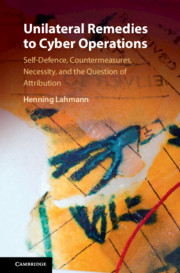 Unilateral Remedies to Cyber Operations
Unilateral Remedies to Cyber Operations Book contents
- Unilateral Remedies to Cyber Operations
- Unilateral Remedies to Cyber Operations
- Copyright page
- Dedication
- Contents
- Preface
- Acknowledgements
- Part I Cybersecurity Incidents and International Law
- 1 The Spectre of Cyberwar
- 2 Terminology
- 3 International Legal Framework
- Part II Unilateral Remedies to Cybersecurity Incidents
- Part III Outlines of an Emergency Regime for Cyberspace
- Bibliography
- Index
3 - International Legal Framework
from Part I - Cybersecurity Incidents and International Law
Published online by Cambridge University Press: 31 March 2020
- Unilateral Remedies to Cyber Operations
- Unilateral Remedies to Cyber Operations
- Copyright page
- Dedication
- Contents
- Preface
- Acknowledgements
- Part I Cybersecurity Incidents and International Law
- 1 The Spectre of Cyberwar
- 2 Terminology
- 3 International Legal Framework
- Part II Unilateral Remedies to Cybersecurity Incidents
- Part III Outlines of an Emergency Regime for Cyberspace
- Bibliography
- Index
Summary
This chapter analyses the ways in which rules of current international law, based in both treaty and customary law, apply to adversarial state conduct in cyberspace. First, it is examined if and under which circumstances malicious cyber operations can amount to a prohibited use of force pursuant to Article 2(4) of the UN Charter. Both state practice and scholarly literature in this regard are closely scrutinised. Further on, the chapter zooms in on the customary principle of non-intervention and inquires how malicious conduct in cyberspace may be in violation of said principle. In particular, state practice and scholarship are consulted in order to clarify the question of what acts would qualify as 'coercion' within the meaning of the intervention doctrine. Finally, it is asked whether there exists a stand-alone rule of respect for sovereignty in international law, and if so, how a cyber operation could infringe on it.
Keywords
- Type
- Chapter
- Information
- Unilateral Remedies to Cyber OperationsSelf-Defence, Countermeasures, Necessity, and the Question of Attribution, pp. 21 - 42Publisher: Cambridge University PressPrint publication year: 2020


